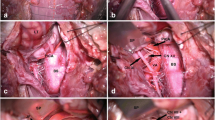Abstract
Background
The subtonsillar transcerebellomedullary approach (STA) has been well established as one of the surgical options to access lesions in the foramen of Luschka. The middle cerebellar peduncle has been defined as the superior limit of this corridor, and tumors extending beyond this landmark were often approached through combined accesses.
Method
We illustrate the access to the suprasellar cistern, from a purely STA for a large tumor arising from the foramen of Luschka.
Conclusion
This manuscript demonstrates the STA as a valid alternative for certain tumors of the foramen of Luschka, which extend into crural and suprasellar cisterns.



Similar content being viewed by others
References
Al R (2000) Tentorial incisura. Neurosurgery 47(3 Suppl):S131–S153. https://doi.org/10.1097/00006123-200009001-00015
Al R (2000) The posterior fossa cisterns. Neurosurgery 47(3 Suppl):S287–S297. https://doi.org/10.1097/00006123-200009001-00029
Herlan S, Ebner FH, Nitz A, Hirt B, Tatagiba M, Roser F (2014) The midline suboccipital subtonsillar approach to the cerebellomedullary cistern and its structures: anatomical considerations, surgical technique and clinical application. Clin Neurol Neurosurg 125:98–105. https://doi.org/10.1016/j.clineuro.2014.07.029
Herlan S, Roser F, Ebner FH, Tatagiba M (2017) How i do it-neurosurgical anatomy The midline suboccipital subtonsillar approach to the cerebellomedullary cistern: how I do it. Emirates Acta Neurochir 159:1613–1617. https://doi.org/10.1007/s00701-017-3270-5
Jean WC, Abdel Aziz KM, Keller JT et al (2003) Subtonsillar approach to the foramen of Luschka: an anatomic and clinical study. Neurosurgery 52(4):860–866. https://doi.org/10.1227/01.NEU.0000053146.83780.74
Matsushima K, Yagmurlu K, Kohno M, Rhoton AL (2016) Anatomy and approaches along the cerebellar-brainstem fissures. J Neurosurg 124(1):248–263. https://doi.org/10.3171/2015.2.JNS142707
Menezes AH (2008) Surgical approaches: postoperative care and complications “posterolateral-far lateral transcondylar approach to the ventral foramen magnum and upper cervical spinal canal.” Child’s Nerv Syst 24(10):1203–1207. https://doi.org/10.1007/s00381-008-0597-5
Rhoton AL (2002) The cerebrum. Neurosurgery 51(4 SUPPL.):1–51. https://doi.org/10.1097/00006123-200210001-00002
Ucerler H, Saylam CY, Cagli S, Orhan M, Zileli M (2008) The posterior inferior cerebellar artery and its branches in relation to the cerebellomedullary fissure. Clin Anat 21(2):119–126. https://doi.org/10.1002/ca.20581
Ziyal IM, Sekhar LN, Salas E (1999) Subtonsillar-transcerebellomedullary approach to lesions involving the fourth ventricle, the cerebellomedullary fissure and the lateral brainstem. Br J Neurosurg 13(3):276–284. https://doi.org/10.1080/02688699943682
Author information
Authors and Affiliations
Corresponding author
Ethics declarations
Ethics approval
The study did not require IRB approval by the Ethics Committee.
Informed consent
The parents of the patient did provide informed consent for the procedure and for the publication of the manuscript.
Conflict of interest
The authors declare no competing interests.
Additional information
Publisher's note
Springer Nature remains neutral with regard to jurisdictional claims in published maps and institutional affiliations.
Key Points
1. The subtonsillar approach represents an alternative for certain large tumors of the foramen of Luschka that extend supratentorially into crural and suprasellar cistern.
2. Lateral extension into the ambient cistern may require supracerebellar approach.
3. In large tumors extending from the foramen of Luschka superiorly, the middle cerebellar peduncle is usually displaced posteriorly and laterally.
4. This corridor allows access to certain tumors in a single stage, instead of more involved combined lateral and medial or staged approaches.
5. Finding the interface between tumor and brainstem and subsequently the origin of lower cranial nerves is key to decreasing the risk of cranial nerve injury.
6. Taking advantage of the corridor created by the tumor avoids any significant retraction of the tonsil to access the suprasellar cistern.
7. PICA should be identified in the cleft between the tonsil and the roof of the 4th ventricle and the AICA in the cerebellopontine cistern, anterior, and superior to the cerebellomedullary fissure.
8. A limitation of this approach is for tumors that extend in front of the brainstem, especially those that cross the basilar artery to the contralateral side.
9. Transient lower cranial nerve dysfunction can be expected postoperatively and should be discussed with the patient.
10. Electrophysiological monitoring of the cranial nerves is key to reducing the risk of injury.
This article is part of the Topical Collection on Tumor—Other
Supplementary Information
Below is the link to the electronic supplementary material.
Supplementary file1 (MP4 287032 KB) Video 1 2D surgical video of the subtonsillar transcerebellomedullary approach
Rights and permissions
About this article
Cite this article
McClugage, S.G., Weiner, H.L. & Aldave, G. Maximizing the subtonsillar transcerebellomedullary approach to suprasellar cistern: how I do it. Acta Neurochir 164, 751–755 (2022). https://doi.org/10.1007/s00701-021-05033-5
Received:
Accepted:
Published:
Issue Date:
DOI: https://doi.org/10.1007/s00701-021-05033-5




